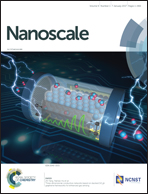Flexible all-solid-state supercapacitors based on polyaniline orderly nanotubes array†
Abstract
Flexible all-solid-state supercapacitors are crucial to meet the growing needs for portable electronic devices such as foldable phones and wearable electronics. As promising candidates for pseudocapacitor electrode materials, polyaniline (PANI) orderly nanotube arrays are prepared via a simple template electrodeposition method. The structures of the final product were characterized using various characterization techniques, including scanning electron microscopy (SEM), Fourier transform infrared spectroscopy (FT-IR), and X-ray photoelectron spectroscopy (XPS). The obtained PANI nanotube film could be directly used as a flexible all-solid-state supercapacitor electrode. Electrochemical results show that the areal capacitance of a PANI nanotube-based supercapacitor with the deposition cycle number of 100 can achieve a maximum areal capacitance of 237.5 mF cm−2 at a scan rate of 10 mV s−1 and maximum energy density of 24.31 mW h cm−2 at a power density of 2.74 mW cm−2. In addition, the prepared supercapacitor exhibits excellent flexibility under different bending conditions. It retains 95.2% of its initial capacitance value after 2000 cycles at a current density of 1.0 mA cm−1, which displays its superior cycling stability. Moreover, the prepared flexible all-solid-state supercapacitor can power a light-emitting-diode (LED), which meets the practical applications of micropower supplies.


 Please wait while we load your content...
Please wait while we load your content...